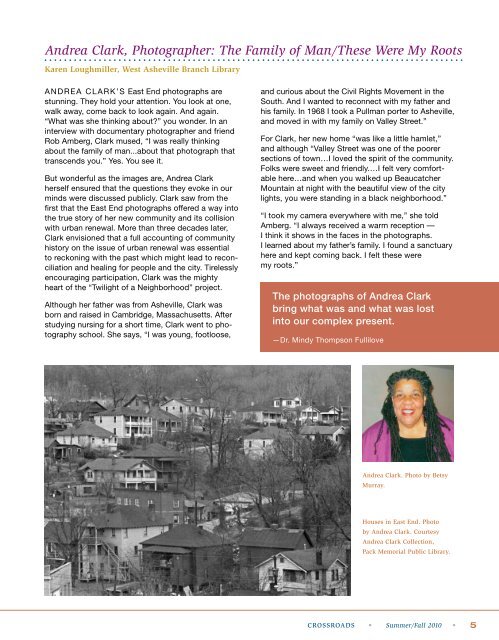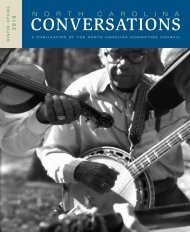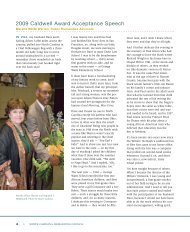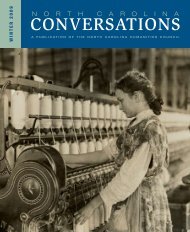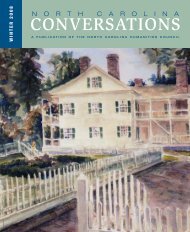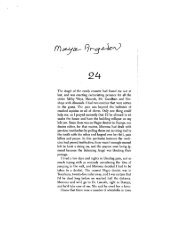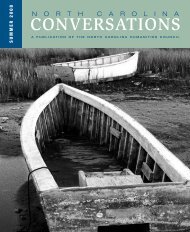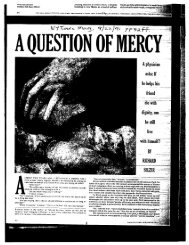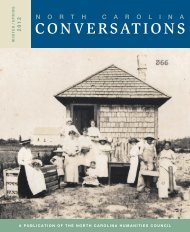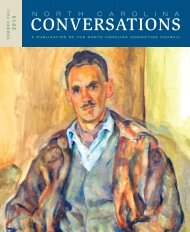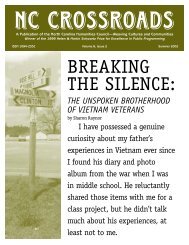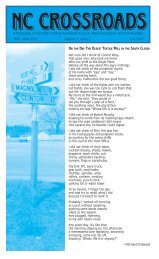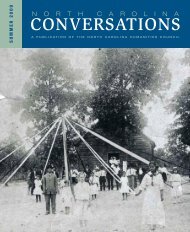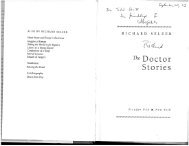Twilight of a Neighborhood - North Carolina Humanities Council
Twilight of a Neighborhood - North Carolina Humanities Council
Twilight of a Neighborhood - North Carolina Humanities Council
Create successful ePaper yourself
Turn your PDF publications into a flip-book with our unique Google optimized e-Paper software.
Andrea Clark, Photographer: The Family <strong>of</strong> Man/These Were My Roots<br />
Karen Loughmiller, West Asheville Branch Library<br />
AnDrEA CLArK’S East End photographs are<br />
stunning. They hold your attention. You look at one,<br />
walk away, come back to look again. And again.<br />
“what was she thinking about?” you wonder. in an<br />
interview with documentary photographer and friend<br />
rob Amberg, Clark mused, “i was really thinking<br />
about the family <strong>of</strong> man...about that photograph that<br />
transcends you.” Yes. You see it.<br />
But wonderful as the images are, Andrea Clark<br />
herself ensured that the questions they evoke in our<br />
minds were discussed publicly. Clark saw from the<br />
first that the East End photographs <strong>of</strong>fered a way into<br />
the true story <strong>of</strong> her new community and its collision<br />
with urban renewal. More than three decades later,<br />
Clark envisioned that a full accounting <strong>of</strong> community<br />
history on the issue <strong>of</strong> urban renewal was essential<br />
to reckoning with the past which might lead to reconciliation<br />
and healing for people and the city. Tirelessly<br />
encouraging participation, Clark was the mighty<br />
heart <strong>of</strong> the “<strong>Twilight</strong> <strong>of</strong> a neighborhood” project.<br />
Although her father was from Asheville, Clark was<br />
born and raised in Cambridge, Massachusetts. After<br />
studying nursing for a short time, Clark went to photography<br />
school. She says, “i was young, footloose,<br />
and curious about the Civil rights Movement in the<br />
South. And i wanted to reconnect with my father and<br />
his family. in 1968 i took a Pullman porter to Asheville,<br />
and moved in with my family on valley Street.”<br />
For Clark, her new home “was like a little hamlet,”<br />
and although “valley Street was one <strong>of</strong> the poorer<br />
sections <strong>of</strong> town…i loved the spirit <strong>of</strong> the community.<br />
Folks were sweet and friendly.…i felt very comfortable<br />
here…and when you walked up Beaucatcher<br />
Mountain at night with the beautiful view <strong>of</strong> the city<br />
lights, you were standing in a black neighborhood.”<br />
“i took my camera everywhere with me,” she told<br />
Amberg. “i always received a warm reception —<br />
i think it shows in the faces in the photographs.<br />
i learned about my father’s family. i found a sanctuary<br />
here and kept coming back. i felt these were<br />
my roots.”<br />
The photographs <strong>of</strong> Andrea Clark<br />
bring what was and what was lost<br />
into our complex present.<br />
—Dr. Mindy Thompson Fullilove<br />
Andrea Clark. Photo by Betsy<br />
Murray.<br />
Houses in East End. Photo<br />
by Andrea Clark. Courtesy<br />
Andrea Clark Collection,<br />
Pack Memorial Public Library.<br />
CROSSROADS • Summer/Fall 2010 • 5


